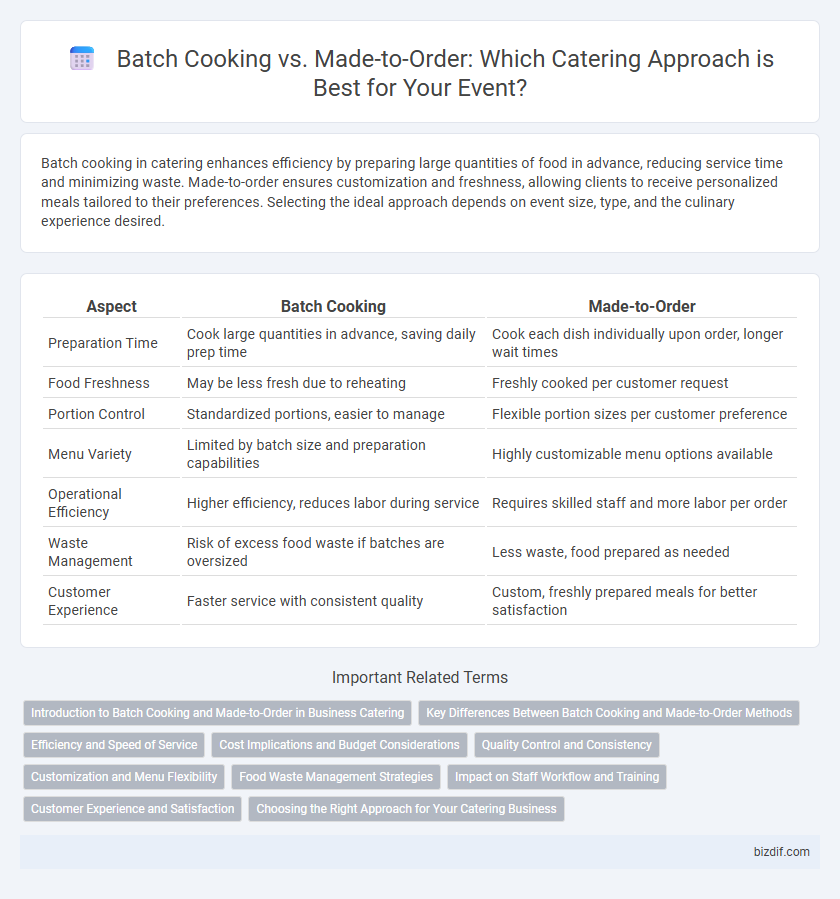Batch cooking in catering enhances efficiency by preparing large quantities of food in advance, reducing service time and minimizing waste. Made-to-order ensures customization and freshness, allowing clients to receive personalized meals tailored to their preferences. Selecting the ideal approach depends on event size, type, and the culinary experience desired.
Table of Comparison
| Aspect | Batch Cooking | Made-to-Order |
|---|---|---|
| Preparation Time | Cook large quantities in advance, saving daily prep time | Cook each dish individually upon order, longer wait times |
| Food Freshness | May be less fresh due to reheating | Freshly cooked per customer request |
| Portion Control | Standardized portions, easier to manage | Flexible portion sizes per customer preference |
| Menu Variety | Limited by batch size and preparation capabilities | Highly customizable menu options available |
| Operational Efficiency | Higher efficiency, reduces labor during service | Requires skilled staff and more labor per order |
| Waste Management | Risk of excess food waste if batches are oversized | Less waste, food prepared as needed |
| Customer Experience | Faster service with consistent quality | Custom, freshly prepared meals for better satisfaction |
Introduction to Batch Cooking and Made-to-Order in Business Catering
Batch cooking in business catering involves preparing large quantities of food in advance, ensuring consistent quality and efficient use of resources during peak service times. Made-to-order catering focuses on customizing each dish according to client specifications, enhancing freshness and personalization but requiring flexible kitchen operations. Choosing between batch cooking and made-to-order depends on the event size, menu complexity, and desired customer experience.
Key Differences Between Batch Cooking and Made-to-Order Methods
Batch cooking involves preparing large quantities of food in advance, ensuring consistent quality and efficient use of resources, ideal for events with predictable attendance. Made-to-order caters to individual preferences, offering fresher dishes but requiring longer preparation times and more skilled staff. The balance between these methods depends on the scale, menu complexity, and customer expectations in catering operations.
Efficiency and Speed of Service
Batch cooking streamlines catering operations by preparing large quantities of dishes in advance, significantly reducing service time during peak hours and minimizing kitchen chaos. Made-to-order service offers customization and freshness but can slow down overall efficiency due to individualized preparation times and higher labor demands. Optimal catering efficiency often balances batch cooking for staple items with made-to-order options to meet diverse client preferences while maintaining quick service.
Cost Implications and Budget Considerations
Batch cooking reduces overall food costs by allowing bulk purchasing and minimizing labor expenses, making it ideal for large-scale catering events with fixed budgets. Made-to-order preparations, while offering higher freshness and customization, often increase labor and ingredient costs due to individualized portioning and potential food waste. Catering businesses must balance cost efficiency with client preferences to optimize budget allocations and maintain profitability.
Quality Control and Consistency
Batch cooking ensures consistent quality by preparing large quantities under standardized conditions, reducing variability and maintaining flavor profiles across servings. Made-to-order allows for customization and freshness but may introduce inconsistencies due to variations in timing and individual preparation. Effective quality control in catering balances these methods to deliver both reliability and tailored dining experiences.
Customization and Menu Flexibility
Batch cooking in catering streamlines meal preparation by producing large quantities of standardized dishes, limiting customization options but enhancing efficiency for high-volume events. Made-to-order catering prioritizes menu flexibility, allowing clients to specify ingredients, portion sizes, and dietary preferences, ensuring personalized meals tailored to individual tastes. Choosing between batch cooking and made-to-order depends on the event's scale and the importance placed on customization and menu adaptability.
Food Waste Management Strategies
Batch cooking in catering reduces food waste by preparing large quantities in advance, allowing for better portion control and efficient use of ingredients. Made-to-order minimizes excess by cooking only what customers request, significantly lowering the risk of uneaten food. Implementing smart inventory tracking and predictive analytics further enhances waste management in both methods.
Impact on Staff Workflow and Training
Batch cooking streamlines staff workflow by standardizing food preparation, reducing cooking times, and allowing efficient use of kitchen equipment and labor. Made-to-order requires specialized training for kitchen staff to handle diverse menu requests and maintain high-quality standards under time pressure. The increased complexity in made-to-order service can demand more flexible scheduling and ongoing skill development, impacting overall operational efficiency.
Customer Experience and Satisfaction
Batch cooking ensures consistent meal quality and faster service times, enhancing customer satisfaction by reducing wait times during peak hours. Made-to-order options provide personalized dining experiences, catering to individual preferences and dietary restrictions, which increases perceived value and customer loyalty. Choosing the right approach depends on the event scale and customer expectations to optimize overall satisfaction and operational efficiency.
Choosing the Right Approach for Your Catering Business
Batch cooking maximizes efficiency and consistency by preparing large quantities of food in advance, ideal for high-volume catering events with predictable menus. Made-to-order offers customization and freshness, perfect for personalized experiences and accommodating specific dietary preferences. Selecting the right approach depends on your event size, menu complexity, and customer expectations to balance quality and operational flow.
Batch cooking vs Made-to-order Infographic

 bizdif.com
bizdif.com